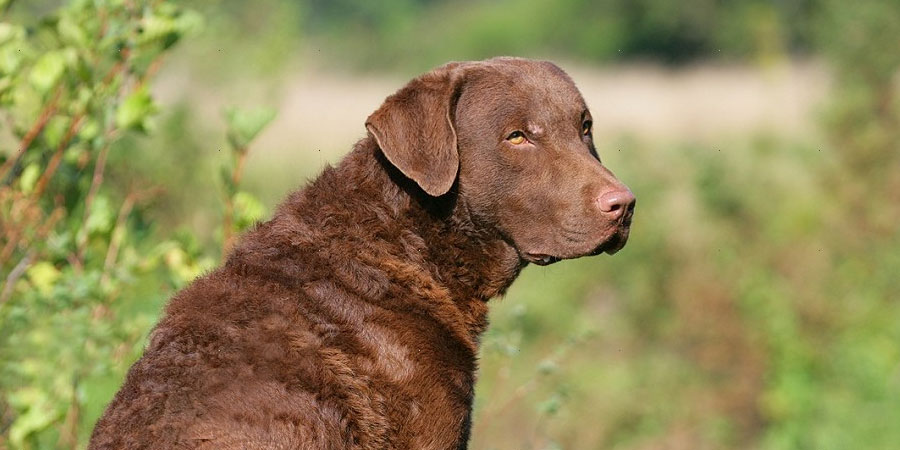

Chessie, CBR, Chesapeake
Overview
The Chesapeake Bay retriever was developed to hunt waterfowl under adverse conditions, facing strong tides in rough water, high winds and sometimes even having to break through ice. It is an extraordinary swimmer, with a strong, yet tender, bite enabling it to carry birds. It has powerful limbs and webbed feet. The Chessie is slightly longer than tall, with its hindquarters as high, or higher, than its forequarters. Its coat is rendered virtually waterproof by virtue of its oily, harsh outer coat and dense wooly undercoat. The color matches its working surroundings: any shade of brown, sedge or dead grass.
The Chesapeake Bay retriever is hardy enough to not only withstand, but also relish, repeated plunges into icy water. It loves to swim and retrieve. Despite an active life when outdoors, inside it tends to be calm. The Chessie tends to be independent, although it is eager to learn. It is reserved with strangers and can be protective; it also can be aggressive toward strange dogs if challenged. This is the hardiest, most strong-willed and protective of the retriever breeds.
| Size | Large |
| Height | Male: 23-26 inches (58-66 cm)Female: 21-24 inches (53-61 cm) |
| Weight | Male: 65-80 pounds (29-36 kg)Female: 55-70 pounds (25-32 kg) |
| Lifespan | 10-13 years |
| Colors | Brown Dark Brown Dark Deadgrass Deadgrass Light Brown Light Deadgrass Sedge |
| Origin | United States |
| Classification | Purebred |
| Good Lapcat |
| Good In Apartments |
Chesapeake Bay Retrievers are not recommended for apartment life. They are relatively inactive indoors and will do best with at least an average-sized yard. Chesapeake Bay Retrievers often enjoy sleeping outdoors if it is cooler outside, as they prefer cool climates. |
| Good With Children |
Good with Kids: This is a suitable breed for kids and is known to be playful, energetic, and affectionate around them. |
| Good With Dogs |
|
| Good With Cats |
|
| Exercise Needs |
The Chesapeake Bay Retriever is an active dog which needs substantial daily exercise. It enjoys playing field sports and swimming, especially in cold water. |
| Trainability |
Moderately Easy Training: Though the Chesapeake Bay Retriever is intelligent, it is known for being difficult to train. Patience is required as the Chesapeake Bay Retriever is not eager to change its behaviors. A popular expression is ‘You can order a Labrador Retriever and ask a Golden Retriever, but you must negotiate with a Chesapeake Bay Retriever’. Once the Chesapeake Bay Retriever recognizes its handler's authority and understands what is expected of it, it will behave properly going forward. Obedience training is strongly recommended. |
| Affectionate |
|
| Playfulness |
|
| Grooming Requirements |
Low Maintenance: The Chessie has an oily, harsh outer coat atop a dense, fine, woolly undercoat. Dirt and debris brush out easily with a rubber curry brush. The undercoat sheds heavily in the spring, so be prepared to brush the dog more frequently during this time to keep loose hair from collecting on clothing and furniture. |
| Shedding |
Moderate Shedding: Expect this dog to shed regularly. Be prepared to vacuum often. Brushing will reduce shedding as well as make the coat softer and cleaner. |
| Vocalization/Barking |
Occassional |